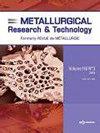Recycling of chromium sludge to promote aggregation and growth of metal during self-reduction of nickel laterite ore
IF 1.1
4区 材料科学
Q3 METALLURGY & METALLURGICAL ENGINEERING
引用次数: 2
Abstract
Addition of stainless steel pickling sludge, which contains hazardous hexavalent chromium, to low-grade nickel laterite ore has the potential to eliminate the hexavalent chromium and promote the aggregation and growth of iron-nickel particles during reduction with anthracite. The effect of chromium sludge on the aggregation and growth of metal particles during a self-reduction process of nickel laterite ore has been studied. The detoxification effect of hexavalent chromium in the sludge was evaluated using the standard TRGS 613 leaching test. Results showed that with increasing chromium sludge addition, the size of metal particles increased. With the addition of 13.94% by mass chromium sludge the average metal particle size in the reduce ore increased from 0.42 µm to 1.38 µm while the recovery of Fe, Ni and Cr increased from 53.73%, 19.39% and 33.36% to 78.33%, 69.22% and 58.26%, respectively. It is proposed that a low melting point eutectic phase of FeS formed in the reduced products, significantly promoted the migration and aggregation of metal particles. Leaching tests indicated that the original chromium sludge released > 600 mg/kg Cr(VI) while the slag from the combined laterite and chromium sludge released less than the EPA limit of 2 mg/kg Cr(VI).铬污泥循环利用促进红土镍矿自还原过程中金属的聚集和生长
在低品位镍红土矿中加入含有有害六价铬的不锈钢酸洗污泥,在无烟煤还原过程中有可能消除六价铬,促进铁镍颗粒的聚集和生长。研究了红土镍矿自还原过程中铬污泥对金属颗粒聚集和生长的影响。采用标准TRGS 613浸出试验评价了污泥中六价铬的解毒效果。结果表明,随着铬污泥添加量的增加,金属颗粒尺寸增大。当质量铬污泥添加量为13.94%时,还原矿中平均金属粒度由0.42µm提高到1.38µm, Fe、Ni和Cr的回收率分别由53.73%、19.39%和33.36%提高到78.33%、69.22%和58.26%。在还原产物中形成了低熔点的FeS共晶相,显著促进了金属颗粒的迁移和聚集。浸出试验表明,原铬污泥释放量> 600 mg/kg Cr(VI),而红土与铬污泥混合后的渣释放量小于EPA规定的2 mg/kg Cr(VI)。
本文章由计算机程序翻译,如有差异,请以英文原文为准。
求助全文
约1分钟内获得全文
求助全文
来源期刊

Metallurgical Research & Technology
METALLURGY & METALLURGICAL ENGINEERING-
CiteScore
1.70
自引率
9.10%
发文量
65
审稿时长
4.4 months
期刊介绍:
Metallurgical Research and Technology (MRT) is a peer-reviewed bi-monthly journal publishing original high-quality research papers in areas ranging from process metallurgy to metal product properties and applications of ferrous and non-ferrous metals and alloys, including light-metals. It covers also the materials involved in the metal processing as ores, refractories and slags.
The journal is listed in the citation index Web of Science and has an Impact Factor.
It is highly concerned by the technological innovation as a support of the metallurgical industry at a time when it has to tackle severe challenges like energy, raw materials, sustainability, environment... Strengthening and enhancing the dialogue between science and industry is at the heart of the scope of MRT. This is why it welcomes manuscripts focusing on industrial practice, as well as basic metallurgical knowledge or review articles.
 求助内容:
求助内容: 应助结果提醒方式:
应助结果提醒方式:


